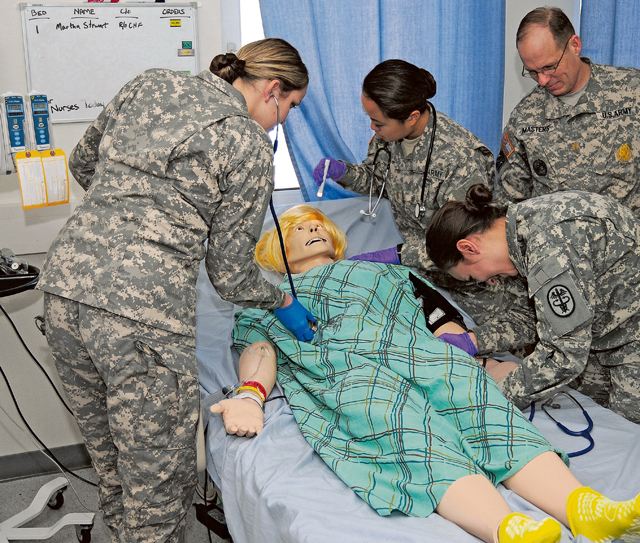
Clinical Nurse Transition Program students practice patient assessment on a high-fidelity manikin at the Landstuhl Regional Medical Center Simulation Center where 496 students have logged 1,280 training hours since the center opened in July 2014.
High fidelity manikin Martha Smith, a 48-year-old female who arrived at the Landstuhl Regional Medical Center emergency room two days ago, was admitted to determine whether she has congestive heart failure or an adverse reaction to calcium channel blocker therapy. Martha is complaining about shortness of breath, has extensive swelling in her lower extremities and a 10-year history of mild to high blood pressure and high cholesterol.
Another manikin, Samuel Smith, or “Sammy,” a 5-year-old male also admitted two days ago with a primary diagnosis of dehydration and gastroenteritis, arrived in the ER suffering from nausea, vomiting and diarrhea during the previous 24 hours. His treatment began with IV fluids, antiemetics (drugs effective against vomiting and nausea) and a broad spectrum IV antibiotic.
At the moment, both Martha and Sammy lay motionless, patiently awaiting the arrival of their medical providers. Although the patients actually arrived at the LRMC Simulation Center, they will be treated with real-world diligence and care by members of the LRMC Clinical Nurse Transition Program.
They were met by Maj. Paul Masters and Tech. Sgt. Michael Reyes, who run a healthy patient assessment scenario culminating in a discharge to home. Martha and Sammy’s nursing staff include 2nd Lts. Heather Eggert, Robert Kalich, Mariel Orbita and Elizabeth Salcido, the newest officers to the CNTP. They are among 496 students who have logged 1,280 training hours since the Simulation Center opened in July 2014. ‘
Simulation scenarios using high fidelity manikins such as Martha and Samuel have recently been added to the CNTP and hospital training schedule and their presence is making a difference.
“Simulation training provides CNTP nurses opportunities to foster critical thinking and leadership skills through simulated medical-surgical patients,” said CNTP Director Kimberly Ganous.
The vision of the LRMC Simulation Center, according to Tech. Sgt. Michael Reyes, is to provide realistic and relevant joint service inter-professional medical/clinical education and training to sustain mission readiness and improve the quality of care for warfighters, veterans and beneficiaries.
In line with this vision, he said the goal is that everyone who enters the simulation center leaves with greater knowledge, confidence and competence to improve patient outcomes.
Future LRMC CNTP officers will complete intensive healthy adult, pediatric and infant assessments during their first week in the program and continue to hone their nursing skills with monthly simulation scenarios focused on caring for patients in all facets of health.
These experiences will allow CNTP participants to practice their skills in caring for labor and delivery patients, adult and pediatric patients with illnesses, or post-surgery and end-of-life patients in a nonthreatening environment.
In addition to supporting the CNTP, the simulation center provides a vehicle to meet or exceed hospital accreditation and 2015 Patient Safety requirements. These requirements include LRMC’s Level 3 Trauma certification requirement to provide a mechanism for trauma-related education for nurses involved in trauma care. The Joint Commission standard for improving competency and ensuring ongoing evaluation and the simulation center provides a realistic training platform for wartime readiness skills for Army and Air Force medical personnel.


